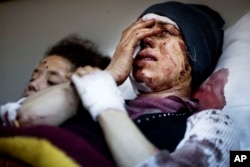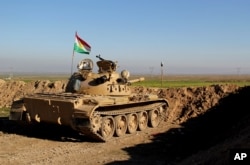Syrian forces supplied by a U.S. ammunition drop last month have helped reclaim nearly 255 square kilometers of ground from Islamic State fighters, according to a senior military official.
Speaking Wednesday from Baghdad by video conference, U.S. Army Colonel Steve Warren told reporters at the Pentagon that Syrian Democratic Forces pressured Islamic State militants from multiple fronts to regain territory around the northeastern town of al-Hawl.
The group, which includes the Syrian Arab Coalition that received the supply drop, was supported from the air by a U.S. AC-130 Spectre gunship and U.S. A-10 warplanes launched from Turkey's Incirlik Air Base.
"The aircraft, because they're only flying from Incirlik into the battlefield, they're able to do more turns, quicker turnover. They're able to loiter longer,” Warren said. “We saw that make a difference here."
The U.S. recently shifted its strategy in Syria from one of vetting and training Syrian fighters outside Syria to one in which the U.S. vets and trains only leaders of Syrian rebel groups while arming their fighters on the Syrian battlefield. The airdrop of 50 tons of ammunition and grenades to Syrian Arab Coalition fighters on October 12 was the first step.
The U.S. also adjusted its strategy to put a small group of fewer than 50 special operations forces inside Syria to help local forces with tactics, operational planning and logistics.
“This al-Hawl operation really was a validator for that program,” said Warren, spokeman for the U.S.-led coalition. “We're going to continue to operate this way as long as it works well. If needed, we'll adjust."
At least 80 IS deaths
Al-Hawl is a mostly Arab town that was held by several hundred Islamic State fighters, Warren said. He said more than 1,000 “friendly” Syrian forces worked together to retake the area, killing at least 80 Islamic State militants.
Warren said the U.S. would continue to supply the Syrian Arab Coalition with ammunition, although he did not say when the next airdrop would occur.
While the recent gains are good news for the coalition, it is too soon to say the adjusted Syria plan is “working,” according to Michael O’Hanlon, a defense policy expert with the Brookings Institution, a public policy research group in Washington.
“It should not be viewed either as a proof of the new strategy or a result of the new strategy, and by itself, it’s not likely to be indicative of any big trend,” O’Hanlon told VOA.
During the past year, most of the victories against Islamic State in northeastern Syria have been by Kurdish forces in predominantly Kurdish areas.
In addition to gains in al-Hawl, Warren said rebel forces pressured Islamic State fighters this week along the so-called Mara line, a western boundary of Islamic State territory that runs north of Aleppo and near the border with Turkey.
Turkey provided synchronized air support with F-16 warplanes to vetted Syrian opposition groups, which included some fighters trained by the U.S. in Turkey.
The offensive killed more than 20 enemy fighters and destroyed several Islamic State fighting positions, Warren said.










